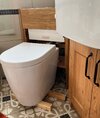i had a read of https://www.diynot.com/diy/threads/i-need-a-jigsaw-blade-to-cut-curves-through-65mm-oak.257877/
I'm hoping to get a piece of oak, to make into a plinth for a toilet to stand on.
the thickness will be around 44mm
but the OH wants the timber to follow the profile from top - seat to floor - which has a slight taper - gors from 360mm at the seat down to 255mm at the floor part of toilet and so she would like that profile to continue
heres an example of the toilet i have - not sure on the exact one but looks the same

 www.victorianplumbing.co.uk
www.victorianplumbing.co.uk
ours came from a local bathroom store, as you can see it tapers from the top and curved around the length
I have a Jigsaw - Dewalt cordless DEWALT DCS331N, i also have an old Bosch corded jigsaw
I dont have a bandsaw
I wondered
a) if the jigsaw would cut 44mm oak ok and if so
b) best blades for the job , i suspect some fine tooth
I have some T101 AOF
 www.screwfix.com
and possibly finish of with a spokeshave which i also have - just need to sharpen the blade on that
www.screwfix.com
and possibly finish of with a spokeshave which i also have - just need to sharpen the blade on that
all suggestions welcome
Thanks
The wood is looking very expensive at the moment £100's so i have another question in different forum about sourcing that - but spending a few quid on a decent blade is not a problem
not sure she will agree to a bandsaw
 or if the table tilts to get the angle - my brother has one - but he is 100miles away - i may be able to go there and see what thats like - no idea what blade he will have - the normal Axminster craft series i think, called workshop now
or if the table tilts to get the angle - my brother has one - but he is 100miles away - i may be able to go there and see what thats like - no idea what blade he will have - the normal Axminster craft series i think, called workshop now
I'll have to check the throat depth on the one he got , I think it was an ex demo at around £500 mark
I'm hoping to get a piece of oak, to make into a plinth for a toilet to stand on.
the thickness will be around 44mm
but the OH wants the timber to follow the profile from top - seat to floor - which has a slight taper - gors from 360mm at the seat down to 255mm at the floor part of toilet and so she would like that profile to continue
heres an example of the toilet i have - not sure on the exact one but looks the same

Arezzo Matt White Rimless Back to Wall Toilet + Soft Close Seat | Victorian Plumbing UK
SHOP the Arezzo Matt White Rimless Back to Wall Toilet + Soft Close Seat at Victorian Plumbing UK
ours came from a local bathroom store, as you can see it tapers from the top and curved around the length
I have a Jigsaw - Dewalt cordless DEWALT DCS331N, i also have an old Bosch corded jigsaw
I dont have a bandsaw
I wondered
a) if the jigsaw would cut 44mm oak ok and if so
b) best blades for the job , i suspect some fine tooth
I have some T101 AOF
Error 410 | Screwfix
Thousands of products at low trade prices | FREE next day delivery available | 30 day money back guarantee on all orders.
all suggestions welcome
Thanks
The wood is looking very expensive at the moment £100's so i have another question in different forum about sourcing that - but spending a few quid on a decent blade is not a problem
not sure she will agree to a bandsaw
I'll have to check the throat depth on the one he got , I think it was an ex demo at around £500 mark
Last edited:


